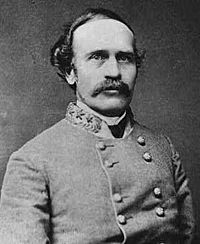Bushrod Johnson facts for kids
Quick facts for kids
Bushrod Johnson
|
|
|---|---|

Bushrod Johnson
|
|
| Born | October 7, 1817 Belmont County, Ohio |
| Died | September 12, 1880 (aged 62) Brighton, Illinois |
| Place of burial | |
| Allegiance | |
| Service/ |
|
| Years of service | 1840–1847 (USA) 1861–1865 (CSA) |
| Rank | |
| Unit | 3rd U.S. Infantry |
| Commands held | Fort Donelson Left Wing, Army of Central Kentucky Johnson's Brigade Johnson's Division |
| Battles/wars | Seminole War |
| Other work | Educator |
Bushrod Rust Johnson (born October 7, 1817 – died September 12, 1880) was an important general for the Confederate side during the American Civil War. Before the war, he was also an officer in the United States Army. Johnson was a university professor and active in the state militias of Kentucky and Tennessee. Even though he was born in the North to a family who opposed slavery, he chose to fight for the South when the war began. He was wounded at the Battle of Shiloh and commanded a division. He also served under General Robert E. Lee during the long Siege of Petersburg and surrendered with him at Appomattox.
Contents
Early Life and Education
Bushrod Johnson was born in Belmont County, Ohio. He grew up in a Quaker family, a group known for their peaceful beliefs. Before moving South, he even helped people escape slavery through the Underground Railroad with his uncle.
He studied at the United States Military Academy and graduated in 1840. After graduating, he became a second lieutenant in the 3rd U.S. Infantry. He fought in the Seminole War in Florida and later in the Mexican–American War. In 1847, he had to leave the army after facing accusations.
After leaving the military, Johnson became a professor. He taught natural philosophy and chemistry at the Western Military Institute in Kentucky from 1848 to 1849. Then, he taught mathematics and engineering at the University of Nashville from 1849 to 1861. During this time, he was also active in the state militias of Kentucky and Tennessee, reaching the rank of colonel. His wife, Mary, passed away before the war, leaving him with a young son who needed special care.
Service in the Civil War
When the Civil War started, Bushrod Johnson joined the Tennessee Militia on June 28, 1861, as a colonel of engineers. A week later, he joined the Confederate States Army. Before starting his war service, he traveled North to leave his son with relatives. His son grew up believing his father was fighting for the Union.
Johnson helped choose the locations for two important river forts: Fort Donelson on the Cumberland River and Fort Henry on the Tennessee River. Fort Henry, however, was built on swampy land and often flooded, making it easy for Union forces to capture. Johnson was promoted to brigadier general on January 24, 1862.
Fort Donelson and Escape
Just before the Battle of Fort Donelson, Johnson was briefly in charge of the fort. However, a higher-ranking general, Gideon J. Pillow, soon took command. Johnson led a division of the army at Donelson. The fort and its army surrendered to Union General Ulysses S. Grant on February 16, 1862. Amazingly, two days later, Johnson managed to walk through the Union lines without being stopped and escaped capture.
Key Battles and Commands
Johnson commanded a brigade at the Battle of Shiloh. On the second day of the battle, April 7, 1862, he became a division commander. He was severely wounded by an artillery shell explosion. For the next year, his brigade served under different commanders in Braxton Bragg's Army of Tennessee. He fought in battles like Battle of Perryville and Battle of Stones River.
Later, at the Battle of Chickamauga, Johnson's brigade helped secure Reed's Bridge. His men also saw action against Union forces and were part of a Confederate push. After this, Johnson, now commanding a division, went with General James Longstreet's forces to the Siege of Knoxville.
Petersburg Campaign
After spending the winter in northeastern Tennessee, Johnson's forces were sent to Virginia to help General Robert E. Lee. Johnson was then sent to Petersburg to command a division under General P. G. T. Beauregard. During the Bermuda Hundred Campaign, Johnson's division stopped a Union advance at Swift Creek on May 9. He was promoted to major general on May 21.
During the long Siege of Petersburg, Johnson's division defended a section of the Confederate lines. On July 30, a mine was exploded under part of his division's position in the Battle of the Crater. Despite the surprise attack, his men fought back bravely. Later, Johnson's division was assigned to Anderson's Fourth Corps under General Lee.
Johnson's division spent seven months in the trenches during the siege. In March 1865, his division was moved to meet a Union attack and fought at Lewis's Farm and White Oak Road. Two of his brigades were sent to General George E. Pickett at Battle of Five Forks and were largely destroyed there. Johnson led the rest of his division in the retreat toward Appomattox. At Sailor's Creek on April 6, his division was shattered, but Johnson managed to escape capture. General Lee relieved Johnson of command on April 8. He stayed with the army until the surrender at Appomattox Court House, where he was released.
After the War
After the war, Bushrod Johnson returned to teaching. He became a professor and co-chancellor of the University of Nashville in 1870, working with another former Confederate General, Edmund Kirby Smith.
His health began to fail, so he retired in 1875 to a farm near Brighton, Illinois. He passed away there in 1880. He was first buried near Brighton, but in 1975, his remains were moved to Old City Cemetery in Nashville, Tennessee. He was reburied next to his wife, Mary.
See also

